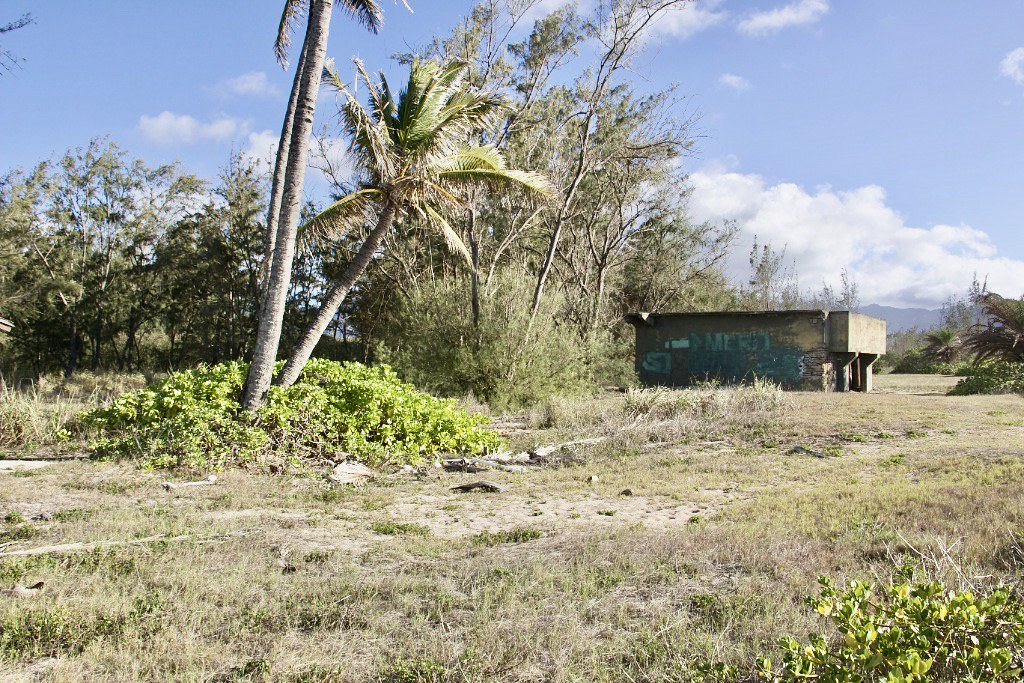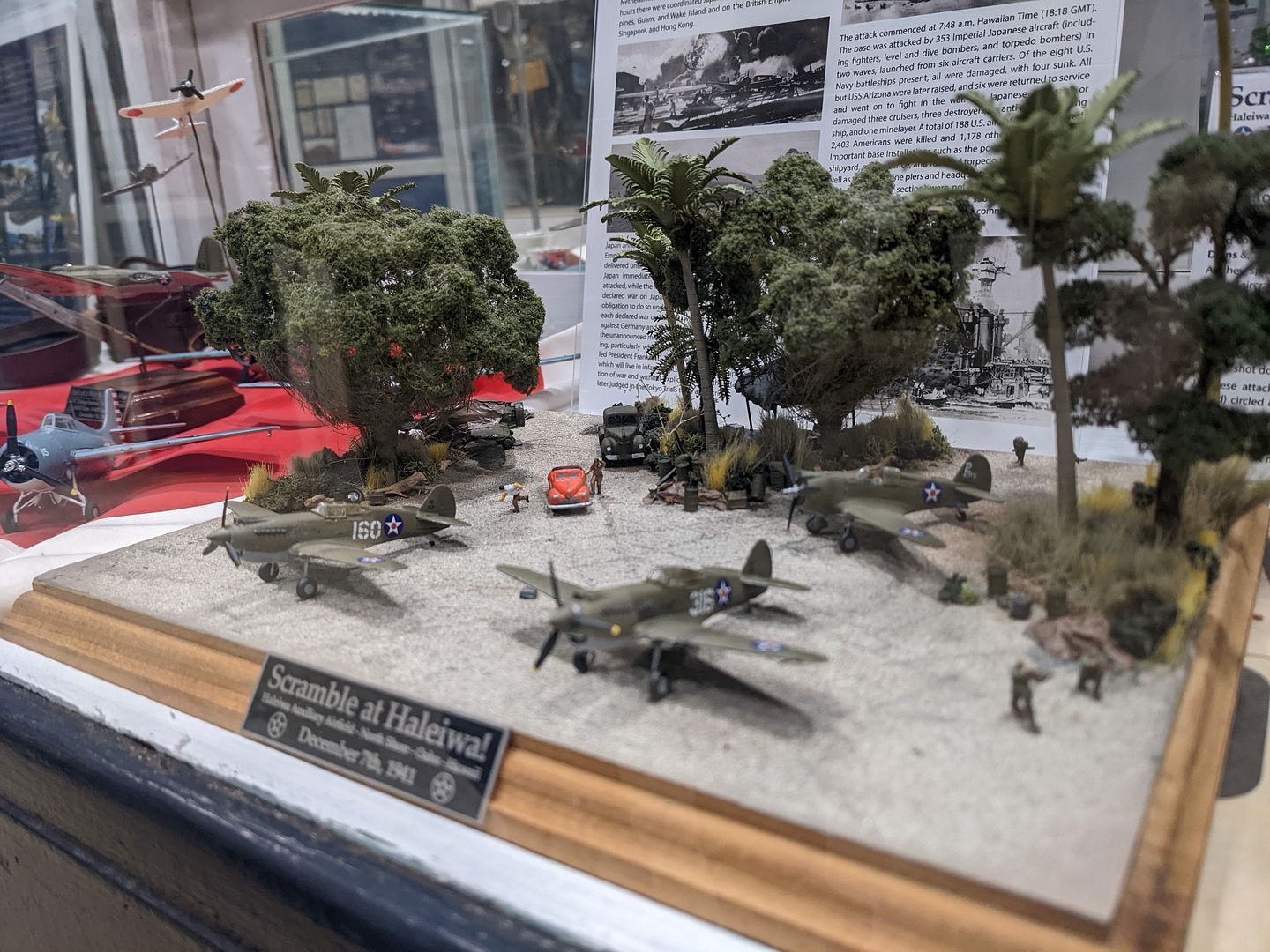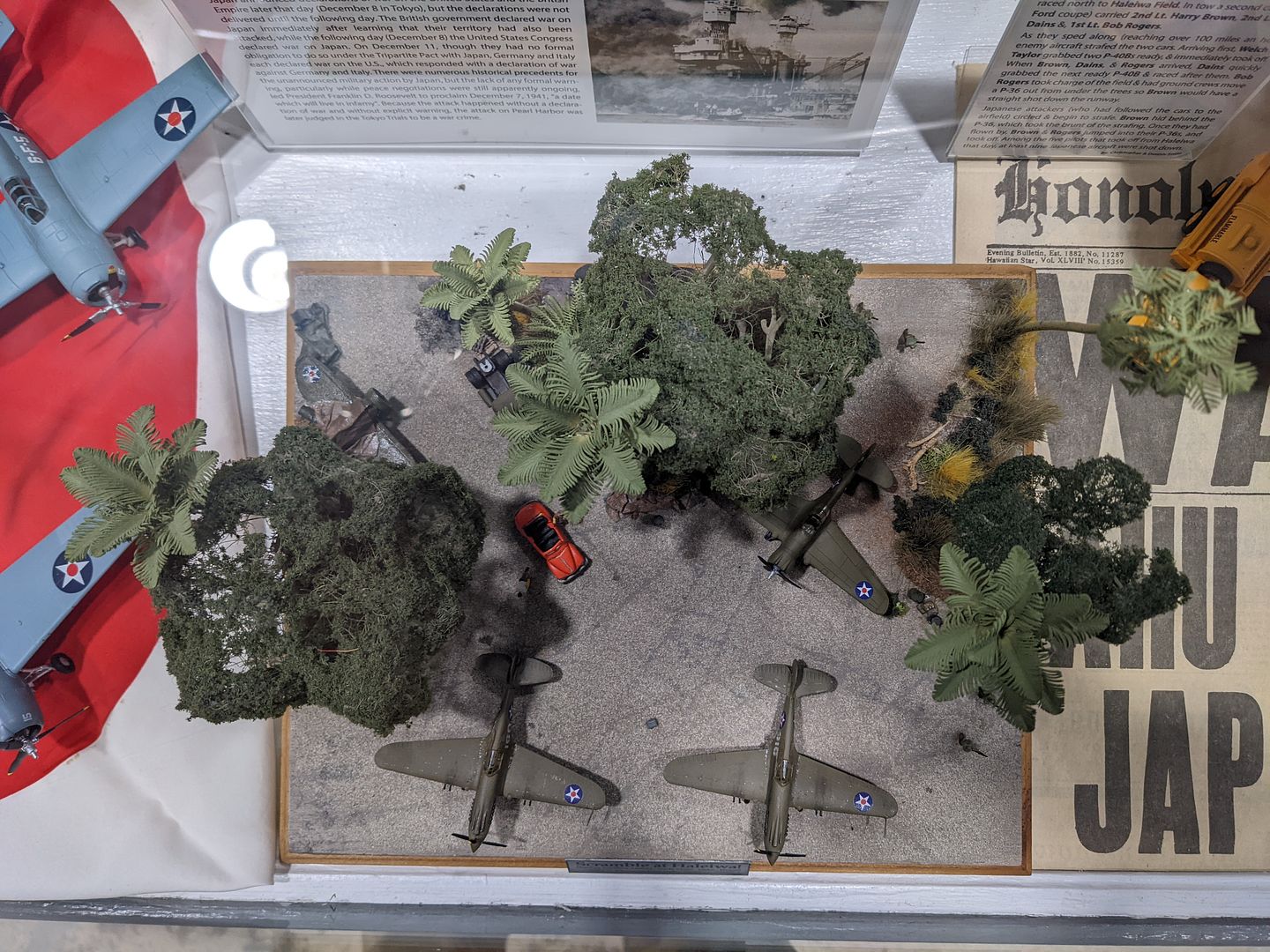Haleiwa, Hawaii
Thu Nov 17, 2022 3:11 am
Haleiwa on the North shore of the island of Oahu in Hawaii, this is the airstrip that the two P40s
piloted by 2nd Lt. George S. Welch and 2nd Lt. Kenneth M. Taylor took off from to take on the
attacking Japanese aircraft over Pearl Harbour in 1941.
See link below.......
https://en.wikipedia.org/wiki/Haleiwa_Fighter_Strip
I believe this is the base of the control tower



piloted by 2nd Lt. George S. Welch and 2nd Lt. Kenneth M. Taylor took off from to take on the
attacking Japanese aircraft over Pearl Harbour in 1941.
See link below.......
https://en.wikipedia.org/wiki/Haleiwa_Fighter_Strip
I believe this is the base of the control tower



Re: Haleiwa, Hawaii
Thu Nov 17, 2022 10:22 am
Thanks for these photos! A place I often think about and would love to visit one day. I became fascinated by this one location and moment in American history on Dec 7th since it was immortalized in the 1970 movie Tora! Tora! Tora!
A little addition to your comments. A total of eight P-40's and 2 P-36's were at Haleiwa on the morning of December 7th, with at least 5 pilots getting airborne. Taylor and Welch were the first to arrive on site and grabbed the first two P-40s ready to go. Harry W. Brown, Johnny Dains, and Robert J. Rogers arrived next, with Brown and Dains both taking the two P-36s. Dains flew a P-40 and was shot down by friendly fire later in the day.
Here is a 1/144th diorama I created trying to accurately portray the actual events from that morning. I still have a few things I'd like to do to this diorama (namely add one more P-40) but its okay for now.



A little addition to your comments. A total of eight P-40's and 2 P-36's were at Haleiwa on the morning of December 7th, with at least 5 pilots getting airborne. Taylor and Welch were the first to arrive on site and grabbed the first two P-40s ready to go. Harry W. Brown, Johnny Dains, and Robert J. Rogers arrived next, with Brown and Dains both taking the two P-36s. Dains flew a P-40 and was shot down by friendly fire later in the day.
Here is a 1/144th diorama I created trying to accurately portray the actual events from that morning. I still have a few things I'd like to do to this diorama (namely add one more P-40) but its okay for now.



Re: Haleiwa, Hawaii
Thu Nov 17, 2022 10:27 am
Is that a P-26 "Peashooter" at the back of the diorama? - what is the story there?
Was there actually a P-26 at that small base on PH Day? Anywhere else in Hawaii?
Was there actually a P-26 at that small base on PH Day? Anywhere else in Hawaii?
Re: Haleiwa, Hawaii
Thu Nov 17, 2022 10:48 am
old iron wrote:Is that a P-26 "Peashooter" at the back of the diorama? - what is the story there?
Was there actually a P-26 at that small base on PH Day? Anywhere else in Hawaii?
In my research (with some original photos) P-26s were present on Oahu at various fields being used as base hacks. So the possibility of a P-26 being present at Haleiwa is possible, though not definitive.
https://www.tapatalk.com/groups/hyperscale/pearl-harbor-p-26-question-with-pix-t185381.html
http://historyyoucanmodel.blogspot.com/2014/07/peashooter-p-26-night-fighter.html
https://hobbymastercollector.com/HA7508.html
Re: Haleiwa, Hawaii
Thu Nov 17, 2022 4:14 pm
Fascinating photos and a great diorama.  It is amazing how much more we seem to know than we did 50 years ago about this event. Keep digging!
It is amazing how much more we seem to know than we did 50 years ago about this event. Keep digging!
Re: Haleiwa, Hawaii
Tue Nov 22, 2022 1:41 pm
I hate to burst your bubble, but the cement block is from the Wastewater Treatment Facility, ex-Haleiwa Field. Notice the extra large pipe on the side.
photo attached of tower at Haleiwa with P-39
Also there were two P-36s on the field 7 December 1941, not P-26s
Originally used as an emergency landing field, in 1941 Haleiwa Field had only an unpaved landing strip and very austere conditions. Haleiwa Field was mainly used to simulate real battle conditions for gunnery training. Little did they know that they would soon be put to the test under real battle conditions? Those on temporary duty there had to bring their own tents & equipment. During the war, the runway was paved and it became a busy reliever base for fighter aircraft patrolling the islands. A World War II era photo depicted a Bell P-39 taxiing past a temporary wooden control tower and another wooden building at Haleiwa (Hawaiian, 2000).
On December 7th the Japanese heavily strafed the aircraft at Wheeler Field and few aircraft were able to get airborne to fend them off. Haleiwa was an auxiliary field to Wheeler and contained a collection of aircraft temporarily assigned to the field including aircraft from the 47th Pursuit Squadron. A total of eight Curtiss P-40 Kitty Hawk and 2 Curtiss P-36 Mohawk pursuit planes were at the field on the morning of 7 December 1941 (Bauer, 2004).
Lt. George S. Welch and 2nd Lt. Kenneth M. Taylor, both P-40 pilots, were at Wheeler when the attack began. They had previously flown their P-40B fighters over to the small airfield at Haleiwa as part of a plan to disperse the squadron’s planes away from Wheeler. Not waiting for instructions the pilots called ahead to Haleiwa and had both their fighters fueled, armed and warmed up. Both men raced in their cars to Haleiwa Field. With their P-40s, now warmed up and ready, they jumped into their cockpits. The crew chiefs informed them that they should disperse their planes. "The hell with that", said Welch. Ignoring the usual pre-takeoff checklists the aircraft took off down the narrow airstrip.
Once in the air they spotted a large number of aircraft in the direction of Ewa and Pearl Harbor. Only then did they realize what they were up against. “There were between 200 and 300 Japanese aircraft," said Taylor; "there were just two of us!" The two P-40's engaged the aircraft attacking Ewa Mooring Mast and shot down five Japanese planes. They then returned to Wheeler to replenish their ammunition. While there, another wave of dive bombers appeared and Lt. Taylor raced back into the air. His P-40's cockpit was damaged as a Japanese plane chased him. Lt. Welch was able to down the plane following him and they both returned back to Wheeler. Lt. Welch was credited with a total of four Japanese planes shot down and Lt. Taylor downed two. Just as suddenly as it began, the sky was empty of enemy aircraft (Jordon, 2000). Both are credited with being the first "Aces" of World War II. Taylor & Welch were both awarded the Distinguished Service Cross." Walsh & Taylor's dramatic ride & takeoff was shown in the movie Tora, Tora, Tora.
After the war Haleiwa Fighter Strip was apparently reused as a civilian airport for some period of time. Haleiwa was depicted as a civilian airport on the 1947 Hawaiian Islands Sectional Chart. It was described as having a 4,800' hard-surface runway. The Haleiwa Airport was apparently abandoned at some point between 1947-61, as it was not depicted at all on the 1961 Honolulu Sectional Chart, and was not depicted at all on recent USGS topo maps.
Little of Haleiwa Field remains today, although the area is not completely abandoned. The remains of the single runway that was paved during World War II can still be seen today but the tarmac is severely compromised by weed growth. The area is currently being used as a motion picture location for various TV shows and movies. Homeless squatters have occupied camps in the heavily overgrown areas. On the north end of the runway still stands the foundation of the control tower and evidence of concrete slabs from building foundations. The land remains undeveloped and is owned by Kamehameha Schools. Hawaiian Historical Aviation Foundation members are interested in restoring part of Haleiwa Field to its original condition, given its national historical importance. The idea is also to create a large open space that can be used for North Shore events (Burlingame, 2005).
photo attached of tower at Haleiwa with P-39
Also there were two P-36s on the field 7 December 1941, not P-26s
Originally used as an emergency landing field, in 1941 Haleiwa Field had only an unpaved landing strip and very austere conditions. Haleiwa Field was mainly used to simulate real battle conditions for gunnery training. Little did they know that they would soon be put to the test under real battle conditions? Those on temporary duty there had to bring their own tents & equipment. During the war, the runway was paved and it became a busy reliever base for fighter aircraft patrolling the islands. A World War II era photo depicted a Bell P-39 taxiing past a temporary wooden control tower and another wooden building at Haleiwa (Hawaiian, 2000).
On December 7th the Japanese heavily strafed the aircraft at Wheeler Field and few aircraft were able to get airborne to fend them off. Haleiwa was an auxiliary field to Wheeler and contained a collection of aircraft temporarily assigned to the field including aircraft from the 47th Pursuit Squadron. A total of eight Curtiss P-40 Kitty Hawk and 2 Curtiss P-36 Mohawk pursuit planes were at the field on the morning of 7 December 1941 (Bauer, 2004).
Lt. George S. Welch and 2nd Lt. Kenneth M. Taylor, both P-40 pilots, were at Wheeler when the attack began. They had previously flown their P-40B fighters over to the small airfield at Haleiwa as part of a plan to disperse the squadron’s planes away from Wheeler. Not waiting for instructions the pilots called ahead to Haleiwa and had both their fighters fueled, armed and warmed up. Both men raced in their cars to Haleiwa Field. With their P-40s, now warmed up and ready, they jumped into their cockpits. The crew chiefs informed them that they should disperse their planes. "The hell with that", said Welch. Ignoring the usual pre-takeoff checklists the aircraft took off down the narrow airstrip.
Once in the air they spotted a large number of aircraft in the direction of Ewa and Pearl Harbor. Only then did they realize what they were up against. “There were between 200 and 300 Japanese aircraft," said Taylor; "there were just two of us!" The two P-40's engaged the aircraft attacking Ewa Mooring Mast and shot down five Japanese planes. They then returned to Wheeler to replenish their ammunition. While there, another wave of dive bombers appeared and Lt. Taylor raced back into the air. His P-40's cockpit was damaged as a Japanese plane chased him. Lt. Welch was able to down the plane following him and they both returned back to Wheeler. Lt. Welch was credited with a total of four Japanese planes shot down and Lt. Taylor downed two. Just as suddenly as it began, the sky was empty of enemy aircraft (Jordon, 2000). Both are credited with being the first "Aces" of World War II. Taylor & Welch were both awarded the Distinguished Service Cross." Walsh & Taylor's dramatic ride & takeoff was shown in the movie Tora, Tora, Tora.
After the war Haleiwa Fighter Strip was apparently reused as a civilian airport for some period of time. Haleiwa was depicted as a civilian airport on the 1947 Hawaiian Islands Sectional Chart. It was described as having a 4,800' hard-surface runway. The Haleiwa Airport was apparently abandoned at some point between 1947-61, as it was not depicted at all on the 1961 Honolulu Sectional Chart, and was not depicted at all on recent USGS topo maps.
Little of Haleiwa Field remains today, although the area is not completely abandoned. The remains of the single runway that was paved during World War II can still be seen today but the tarmac is severely compromised by weed growth. The area is currently being used as a motion picture location for various TV shows and movies. Homeless squatters have occupied camps in the heavily overgrown areas. On the north end of the runway still stands the foundation of the control tower and evidence of concrete slabs from building foundations. The land remains undeveloped and is owned by Kamehameha Schools. Hawaiian Historical Aviation Foundation members are interested in restoring part of Haleiwa Field to its original condition, given its national historical importance. The idea is also to create a large open space that can be used for North Shore events (Burlingame, 2005).
Re: Haleiwa, Hawaii
Tue Nov 22, 2022 2:18 pm
ALOHADAVE wrote:Also there were two P-36s on the field 7 December 1941, not P-26s
I did note above that there were two P-36s at the field AND there were also P-26s on Oahu at the time of the attack, so the possibility of a run down P-26 at Haleiwa is possible, hence why I decided to take some creative liberties and include one within my diorama. Until I see detailed photographic evidence of Haleiwa on Dec 7th (or immediately afterwards) proving without a shadow of a doubt that there were no P-26s present at the field, I think I'll keep it in my diorama.
Re: Haleiwa, Hawaii
Wed Nov 23, 2022 10:40 pm
Dave,can the location of the control tower in that picture be precisly determined? Are the cement pads you mentioned above the same ones holding up the tower?Thanks.
Re: Haleiwa, Hawaii
Tue Nov 29, 2022 10:05 am
no the exact location of the tower can not be determined. I have thoroughly explored the location. The site has changed over the years and is not overgrown.
concrete bunkers were added late in the war built back into the mountain sides
concrete bunkers were added late in the war built back into the mountain sides
- Attachments
-
- Taxi-way ex-Haleiwa Field Bennett.jpg (69.63 KiB) Viewed 2247 times
Re: Haleiwa, Hawaii
Tue Nov 29, 2022 10:05 am
no the exact location of the tower can not be determined. I have thoroughly explored the location. The site has changed over the years and is now overgrown.
concrete bunkers were added late in the war built back into the mountain sides
concrete bunkers were added late in the war built back into the mountain sides
Re: Haleiwa, Hawaii
Tue Nov 29, 2022 10:08 am
no the exact location of the tower can not be determined. I have thoroughly explored the location. The site has changed over the years and is now overgrown.
concrete bunkers were added late in the war built back into the mountain sides
photo of the taxi way
concrete bunkers were added late in the war built back into the mountain sides
photo of the taxi way
Re: Haleiwa, Hawaii
Tue Nov 29, 2022 11:30 am
Warbird Kid wrote:ALOHADAVE wrote:Also there were two P-36s on the field 7 December 1941, not P-26s
I did note above that there were two P-36s at the field AND there were also P-26s on Oahu at the time of the attack, so the possibility of a run down P-26 at Haleiwa is possible, hence why I decided to take some creative liberties and include one within my diorama. Until I see detailed photographic evidence of Haleiwa on Dec 7th (or immediately afterwards) proving without a shadow of a doubt that there were no P-26s present at the field, I think I'll keep it in my diorama.
I'm sure your P-26 is cool, but it sounds more like you want it to be there than that there is any substantial reason to believe it should be there. I don't remember the late David Aiken mentioning anything about P-26s at Haleiwa in his excellent articles on the men who managed to get airborne during the Pearl Harbor raid.
http://joebaugher.com/usaf_fighters/p26_6.html
The P-26 was a popular pilots' airplane and performed well until outclassed by more modern fighters. P-26s served in front-line units with the USAAC until 1938-40, when they began to be replaced by Seversky P-35 and Curtiss P-36A fighters. All P-26 models had been withdrawn from regular squadron use by the time of Pearl Harbor, and most surviving stateside P-26 aircraft had been relegated to mechanic training schools.
There were still some P-26s sitting on the flight line at Wheeler Field at the time of the Japanese attack on Pearl Harbor. Six of them were destroyed and one was damaged.